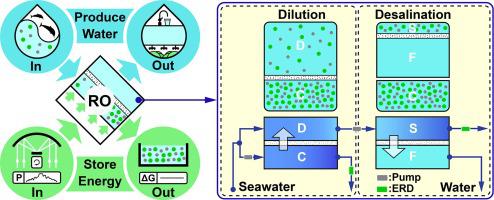当前位置:
X-MOL 学术
›
Energy Convers. Manag.
›
论文详情
Our official English website, www.x-mol.net, welcomes your
feedback! (Note: you will need to create a separate account there.)
Solar energy powered high-recovery reverse osmosis for synchronous seawater desalination and energy storage
Energy Conversion and Management ( IF 9.9 ) Pub Date : 2021-01-01 , DOI: 10.1016/j.enconman.2020.113665 Xiaotian Lai , Rui Long , Zhichun Liu , Wei Liu
Energy Conversion and Management ( IF 9.9 ) Pub Date : 2021-01-01 , DOI: 10.1016/j.enconman.2020.113665 Xiaotian Lai , Rui Long , Zhichun Liu , Wei Liu

|
Abstract Solar energy is clean and sustainable to power our continuously developing society, but the intermittency and unpredictability lays a barrier on its direct connection to the grid. Seawater desalination is an effective path to consume dynamic solar energy to produce fresh water and stable salinity gradient energy simultaneously. Thus, a self-diluted 2-stage reverse osmosis with high recovery ratio is proposed to consume the renewable power from a dish solar Stirling engine to achieve more water production and energy storage. Based on theoretical derivation, system performance is evaluated under ideal membrane property and enough membrane area condition. The influence of hydraulic pressure difference and diluted fraction ratio on water production and energy storage performance are investigated. A performance optimization is further conducted and the corresponding performance are evaluated. Results revealed that self-diluted 2-stage configuration can improve the maximal recovery ratio from 25%, 57% and 70% to 39%, 62% and 72% under the maximal bearable pressure difference of 4, 7 and 10 MPa. Maximal salinity gradient energy of 3.84 MJ can be stored with an overall energy efficiency of 8.42% while desalinating 1 cubic meter seawater of 0.6 M. Theoretical analysis indicates that novel configuration is potentially an effective method to improve the upper separation limitation, which further produces more water and stores more solar energy in the desalination process of finite amount of source seawater.
中文翻译:

太阳能驱动的高回收反渗透同步海水淡化和储能
摘要 太阳能是清洁、可持续的能源,可为我们不断发展的社会提供动力,但其间歇性和不可预测性阻碍了其直接接入电网。海水淡化是利用动态太阳能同时生产淡水和稳定盐度梯度能量的有效途径。因此,提出了一种具有高回收率的自稀释二级反渗透,以消耗来自碟式太阳能斯特林发动机的可再生能源,以实现更多的产水和能量储存。在理论推导的基础上,在理想的膜性能和足够的膜面积条件下评估系统性能。研究了水压差和稀释比对产水和储能性能的影响。进一步进行性能优化并评估相应的性能。结果表明,在4、7和10 MPa的最大可承受压差下,自稀释二级配置可以将最大采收率从25%、57%和70%提高到39%、62%和72%。在淡化 1 立方米 0.6 M 的海水时,可以存储 3.84 MJ 的最大盐度梯度能量,总体能效为 8.42%。 理论分析表明,新的配置可能是提高分离上限的有效方法,从而进一步产生更多在有限量的源海水淡化过程中储存更多的太阳能。结果表明,在4、7和10 MPa的最大可承受压差下,自稀释二级配置可以将最大采收率从25%、57%和70%提高到39%、62%和72%。在淡化 1 立方米 0.6 M 的海水时,可以存储 3.84 MJ 的最大盐度梯度能量,总体能效为 8.42%。 理论分析表明,新的配置可能是提高分离上限的有效方法,从而进一步产生更多在有限量的源海水淡化过程中储存更多的太阳能。结果表明,在4、7和10 MPa的最大可承受压差下,自稀释二级配置可以将最大采收率从25%、57%和70%提高到39%、62%和72%。在淡化 1 立方米 0.6 M 的海水时,可以存储 3.84 MJ 的最大盐度梯度能量,总体能效为 8.42%。 理论分析表明,新的配置可能是提高分离上限的有效方法,从而进一步产生更多在有限量的源海水淡化过程中储存更多的太阳能。
更新日期:2021-01-01
中文翻译:

太阳能驱动的高回收反渗透同步海水淡化和储能
摘要 太阳能是清洁、可持续的能源,可为我们不断发展的社会提供动力,但其间歇性和不可预测性阻碍了其直接接入电网。海水淡化是利用动态太阳能同时生产淡水和稳定盐度梯度能量的有效途径。因此,提出了一种具有高回收率的自稀释二级反渗透,以消耗来自碟式太阳能斯特林发动机的可再生能源,以实现更多的产水和能量储存。在理论推导的基础上,在理想的膜性能和足够的膜面积条件下评估系统性能。研究了水压差和稀释比对产水和储能性能的影响。进一步进行性能优化并评估相应的性能。结果表明,在4、7和10 MPa的最大可承受压差下,自稀释二级配置可以将最大采收率从25%、57%和70%提高到39%、62%和72%。在淡化 1 立方米 0.6 M 的海水时,可以存储 3.84 MJ 的最大盐度梯度能量,总体能效为 8.42%。 理论分析表明,新的配置可能是提高分离上限的有效方法,从而进一步产生更多在有限量的源海水淡化过程中储存更多的太阳能。结果表明,在4、7和10 MPa的最大可承受压差下,自稀释二级配置可以将最大采收率从25%、57%和70%提高到39%、62%和72%。在淡化 1 立方米 0.6 M 的海水时,可以存储 3.84 MJ 的最大盐度梯度能量,总体能效为 8.42%。 理论分析表明,新的配置可能是提高分离上限的有效方法,从而进一步产生更多在有限量的源海水淡化过程中储存更多的太阳能。结果表明,在4、7和10 MPa的最大可承受压差下,自稀释二级配置可以将最大采收率从25%、57%和70%提高到39%、62%和72%。在淡化 1 立方米 0.6 M 的海水时,可以存储 3.84 MJ 的最大盐度梯度能量,总体能效为 8.42%。 理论分析表明,新的配置可能是提高分离上限的有效方法,从而进一步产生更多在有限量的源海水淡化过程中储存更多的太阳能。











































 京公网安备 11010802027423号
京公网安备 11010802027423号